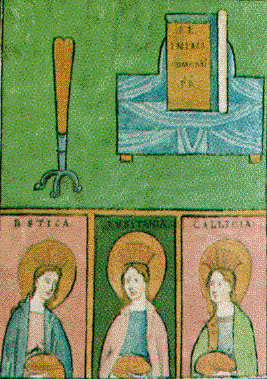 Contents -
Previous Article -
Next Article
Contents -
Previous Article -
Next Article
The office of VICARIVS BRITTANIARVM (Governor of Britain) is represented by a page of the Notitia Dignitatum depicting the island of Britain and its fortified towns. Tthe Romans realized that Britain was an island, but they made no attempt to create an accurate map in its representation of Britain in the Notitia Dignitatum.
The official holding the office of "Count of the Saxon Shore" or, COMES LITORIS SAXONICI PER BRITTANIVM was in charge of the defense of the island. Not only was he in charge of the fortified seacoast towns, but he commanded a powerful naval force that patrolled tha English Channel in oared warships. Even during the period when Rome's strength was greatest in Britain, there were raids by Saxon pirates. The emperor appointed a military officer in charge of a fleet and a ring of forts around the island of Britain to defend against attacks by sea. Representations of the nine Saxon Shore forts can be seen in the page of the Notitia Digninatum depicting the insignia of the Count of the Saxon Shore. The Count of the Saxon Shore held a lot of military power in his hands and were not above the temptation to rebel. This had happened to Carausius, the Roman general entrusted by Diocletian to defend Britain against pirate and Saxon raids. It seems that Carausius had been showing up with his fleet and Roman legions right after pirates had sacked a coastal town. Carausius would immediately set out and overtake the pirates. The trouble was that Carausius never seemed to get around to returning the plundered loot to the rightful owners (or their next of kin). Emperor Maximianus then decided to summon Carausius to his headquarters. It is not really known whether Maximianus suspected that Carausius was abusing his authority at this point. At any rate, Carausius believed he was in big trouble so he persuaded his troops to proclaim him emperor. He ruled Britain and parts of Gaul from A. D. 287 to 393 before he was murdered by Allectus, one of his lieutenants who also wanted a chance to sit upon the throne.
Go to next article:
Go back to previous article:
Return to Table of Contents